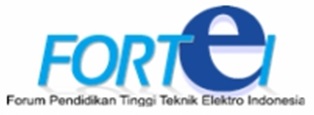Pengembangan Kontroler PID Digital Menggunakan Matlab dan Proteus
Sari
Artikel ini membahas aspek teknis terkait desain dan implementasi kontroler PID digital pada mikrokontroler menggunakan Matlab dan Proteus. Matlab digunakan untuk mencari parameter PID digital yang tepat sesuai dengan beberapa kriteria perancangan, seperti gain margin, frekuensi crossover, dan amplitudo maksimal aktuator. Sedangkan Proteus digunakan untuk mengimplementasi dan menguji PID digital hasil rancangan. PID digital tersebut diimplementasikan pada mikrokontroler AVR 8-bit yang dilengkapi dengan program PID berupa kode C WinAVR. Fungsi alih plant yang akan dikontrol dianggap telah diketahui dan parameter PID ditala menggunakan tool Matlab bernama pidtune. Tahap implementasi dan pengujian dimulai dengan membuat diagram simulasi Proteus yang memuat plant, sensor, aktuator dan kontroler PID. Kode program PID pada mikrokontroler dibuat berdasarkan persamaan beda yang diturunkan dari rumus PID digital hasil diskritisasi Euler Backward. Untuk menjamin bahwa program PID dijalankan sekali setiap waktu sampling yang ditentukan maka kode program PID diletakkan pada vektor interupsi timer. Hasil pengujian dengan waktu sampling 10ms menunjukkan bahwa respon PID digital didalam Proteus sangat mendekati respon PID analog didalam Matlab, dimana selisih output pada waktu mantap hanya 0.0134 atau 0.089% dari setpoint. Hal ini membuktikan bahwa PID yang dirancang menggunakan Matlab telah berhasil diimplementasikan secara digital pada mikrokontroler AVR 8-bit.
This article discusses technical aspects related to design and implementation of digital PID controller on microcontroller using Matlab and Proteus. Matlab is used to find the right digital PID parameters according to some design criterias, such as gain margin, crossover frequency, and maximum actuator amplitude. Meanwhile, Proteus is used to implement and test the designed digital PID. This controller is implemented on an 8-bit AVR microcontroller which is equipped with PID program in the form of WinAVR C code. The plant transfer function to be controlled is assumed to be known and the PID parameters are tuned using Matlab tool named pidtune. The implementation and testing begin by creating Proteus simulation diagram containing plant, sensor, actuator and PID controller. PID program code on the microcontroller is created based on difference equation derived from the digital PID formula result of Euler Backward Discreatization. To guarantee that this program is executed once every specified sampling time, this code is placed in timer interrupt vector. The test results with sampling time 10ms show that Digital PID response in Proteus response is very close to analog PID in Matlab response, where otput difference at setting time is only 0.0134 or 0.089% of setpoint. This proves that the digital PID designed with Matlab has been successfully implemented on 8-bit AVR microcontroller.
Kata Kunci
Teks Lengkap:
PDFDilihat:
Referensi
T. Alamirew, V. Balaji, and N. Gabbeye, “Comparison of PID controller with model predictive controller for milk pasteurization process,” Bulletin of Electrical Engineering and Informatics, vol. 6, no. 1, pp. 24–35, 2017, doi: 10.11591/eei.v6i1.575.
H. Toar, E. Purwanto, H. Oktavianto, R. Ridwan, and M. R. Rusli, “Penala Parameter Pid Otomatis Pada Pengatur Kecepatan Motor Induksi Tiga Fasa,” Jurnal Integrasi, vol. 12, no. 1, pp. 1–12, 2020, doi: 10.30871/ji.v12i1.1372.
P. H. G. Coelho, J. F. M. Amaral, Y. C. Bacelar, E. N. Rocha, M. Bentes, and T. S. Souza, “Tuning Analog PID Controllers by Multi-Objective Genetic Algorithms with Fuzzy Aggregation,” International Conference on Enterprise Information Systems, ICEIS - Proceedings, vol. 1, no. Iceis, pp. 563–571, 2023, doi: 10.5220/0011976900003467.
N. Roongmuanpha, J. Satansup, T. Pukkalanun, and W. Tangsrirat, “Design of Mixed-Mode Analog PID Controller with CFOAs,” Sensors, vol. 24, no. 10, p. 3125, 2024, doi: 10.3390/s24103125.
P. Podržaj, “Contionuous VS discrete PID controller,” 2018 IEEE 9th International Conference on Mechanical and Intelligent Manufacturing Technologies, ICMIMT 2018, vol. 2018-Janua, pp. 177–181, 2018, doi: 10.1109/ICMIMT.2018.8340444.
A. H. Akbar, A. Ma, C. Rekik, A. J. Abougarair, and A. Molla, “Implementing PID Control on Arduino Uno for Air Temperature Optimization,” vol. 6, no. 1, pp. 1–13, 2024, doi: 10.12928/biste.v6i1.9725.
M. F. V. Isdaryani, Feni Hesya and F. Feriyonika, “Sintesis Kendali PID Digital dengan Diskritisasi Langsung dan Backward Difference,” ELKOMIKA: Jurnal Teknik Energi Elektrik, Teknik Telekomunikasi, & Teknik Elektronika, vol. 9, no. 2, p. 467, 2021, doi: 10.26760/elkomika.v9i2.467.
V. Ballerini, C. Biserni, G. Fabbri, P. Guidorzi, E. R. di Schio, and P. Valdiserri, “The Use of Arduino and PID Control Approach for the Experimental Setup of HVAC Temperature Testing,” Journal of Robotics and Control (JRC), vol. 5, no. 2, pp. 482–489, 2024, doi: 10.18196/jrc.v5i2.20915.
B. Setiawan, M. K. Firdaus, S. Wibowo, I. Agafta, and F. Zain, “Identifiying the PID-N method performance for speed control of BLDC motor propeller on catamaran ships model,” Eastern-European Journal of Enterprise Technologies, vol. 3, no. 2 (123), pp. 35–43, Jun. 2023, doi: 10.15587/1729-4061.2023.274713.
H. Supriyono, F. F. Alanro, and A. Supardi, “Development of DC Motor Speed Control Using PID Based on Arduino and Matlab For Laboratory Trainer,” Jurnal Nasional Teknik Elektro, vol. 1, pp. 36–41, 2024, doi: 10.25077/jnte.v13n1.1155.2024.
V. F. Rahmadini, A. Ma’arif, and N. S. Abu, “Design of Water Heater Temperature Control System using PID Control,” Control Systems and Optimization Letters, vol. 1, no. 2, pp. 111–117, Aug. 2023, doi: 10.59247/csol.v1i2.41.
P. Chotikunnan and R. Chotikunnan, “Dual Design PID Controller for Robotic Manipulator Application,” Journal of Robotics and Control (JRC), vol. 4, no. 1, pp. 23–34, 2023, doi: 10.18196/jrc.v4i1.16990.
N. Ramadhani, A. Ma’arif, and A. Çakan, “Implementation of PID Control for Angular Position Control of Dynamixel Servo Motor,” Control Systems and Optimization Letters, vol. 2, no. 1, pp. 8–14, 2024, doi: 10.59247/csol.v2i1.40.
A. Rahman and T. Taali, “Simulator Rangkaian Mikrokontroler Arduino Uno sebagai Media Pembelajaran menggunakan Proteus,” Jurnal Pendidikan Teknik Elektro, vol. 04, no. 01, pp. 125–132, 2023.
S. Buwarda, “Development of a Closed-Loop Controller for an Arduino-Based DC Chopper using Proteus and LabVIEW Research Methodology,” vol. 21, no. 1, pp. 24–27, 2024.
S. Syahminan and C. W. Hidayat, “Development of digital engineering learning with proteus software media and emulators department of informatics engineering Kanjuruhan University,” J Phys Conf Ser, vol. 1869, no. 1, 2021, doi: 10.1088/1742-6596/1869/1/012076.
A. R. Suharso, A. Nuriyanis, A. Hendartono, E. Sirait, and F. S. Kurniawan, “Analysis of The use of Proteus Software as a Practical Learning Support,” vol. 7, no. 1, pp. 30–39, 2024.
P. Mohindru, “Review on PID, fuzzy and hybrid fuzzy PID controllers for controlling non-linear dynamic behaviour of chemical plants,” Artif Intell Rev, vol. 57, no. 4, 2024, doi: 10.1007/s10462-024-10743-0.
K. Sozański, “Low Cost PID Controller for Student Digital Control Laboratory Based on Arduino or STM32 Modules,” Electronics (Switzerland), vol. 12, no. 15, 2023, doi: 10.3390/electronics12153235.
DOI: https://doi.org/10.15575/telka.v11n1.109-118
Refbacks
- Saat ini tidak ada refbacks.
Jurnal TELKA terindex oleh :







Didukung oleh :


Ciptaan disebarluaskan di bawah Lisensi Creative Commons Atribusi-NonKomersial-BerbagiSerupa 4.0 Internasional.



